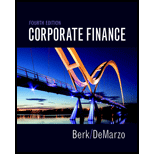
Corporate Finance Plus MyLab Finance with Pearson eText -- Access Card Package (4th Edition) (Berk, DeMarzo & Harford, The Corporate Finance Series)
4th Edition
ISBN: 9780134408897
Author: Jonathan Berk, Peter DeMarzo
Publisher: PEARSON
expand_more
expand_more
format_list_bulleted
Question
Chapter 28.6, Problem 2CC
Summary Introduction
To explain, based on empirical evidence, who gets the value added from a takeover and also give the most likely reasons for such an outcome.
Expert Solution & Answer
Want to see the full answer?
Check out a sample textbook solution
Students have asked these similar questions
Don't use ai.
If you deposit $1,000 in a bank account earning 5% annual interest, how much will you have after 1 year?
A) $1,005B) $1,050C) $1,500D) $1,100
If you deposit $1,000 in a bank account earning 5% annual interest, how much will you have after 1 year?
A) $1,005B) $1,050C) $1,500D) $1,100
No AI
You take a loan of $10,000 at 8% annual interest to be repaid in 4 equal annual installments. What is the annual payment?
Chapter 28 Solutions
Corporate Finance Plus MyLab Finance with Pearson eText -- Access Card Package (4th Edition) (Berk, DeMarzo & Harford, The Corporate Finance Series)
Ch. 28.1 - Prob. 1CCCh. 28.1 - Prob. 2CCCh. 28.2 - On average, what happens to the target share price...Ch. 28.2 - Prob. 2CCCh. 28.3 - What are the reasons most often cited for a...Ch. 28.3 - Prob. 2CCCh. 28.4 - Prob. 1CCCh. 28.4 - What do risk arbitrageurs do?Ch. 28.5 - Prob. 1CCCh. 28.5 - Prob. 2CC
Ch. 28.6 - Prob. 1CCCh. 28.6 - Prob. 2CCCh. 28 - What are the two primary mechanisms under which...Ch. 28 - Prob. 2PCh. 28 - What are some reasons why a horizontal merger...Ch. 28 - Prob. 4PCh. 28 - Prob. 5PCh. 28 - Prob. 6PCh. 28 - How do the carryforward and carryback provisions...Ch. 28 - Diversification is good for shareholders. So why...Ch. 28 - Your company has earnings per share of 4. It has 1...Ch. 28 - If companies in the same industry as TargetCo...Ch. 28 - Prob. 11PCh. 28 - Prob. 12PCh. 28 - Prob. 13PCh. 28 - Lets reconsider part (b) of Problem 99. The actual...Ch. 28 - ABC has 1 million shares outstanding, each of...Ch. 28 - Prob. 16PCh. 28 - How does a toehold help overcome the free rider...Ch. 28 - Prob. 18P
Knowledge Booster
Similar questions
- You take a loan of $10,000 at 8% annual interest to be repaid in 4 equal annual installments. What is the annual payment?arrow_forwardNeed help!! A stock pays a constant dividend of $2.50 per year. If the required rate of return is 10%, what is the value of the stock? A) $20.00B) $22.50C) $25.00D) $27.50arrow_forwardA stock pays a constant dividend of $2.50 per year. If the required rate of return is 10%, what is the value of the stock? A) $20.00B) $22.50C) $25.00D) $27.50arrow_forward
- Don't use chatgpt i will give unhelpful! The beta of a stock is 1.2, the risk-free rate is 3%, and the expected market return is 9%. What is the expected return of the stock using the CAPM?arrow_forwardNo ai A project requires an initial investment of $5,000 and returns $2,000 per year for 3 years. What is the Net Present Value (NPV) at a discount rate of 10%? A) $375.66B) $420.50C) $487.23D) $512.67arrow_forwardWhat is the effective annual rate (EAR) for a nominal interest rate of 12% compounded monthly? A) 12.00%B) 12.36%C) 12.68%D) 13.00%arrow_forward
- Don't use chatgpt. The beta of a stock is 1.2, the risk-free rate is 3%, and the expected market return is 9%. What is the expected return of the stock using the CAPM?arrow_forwardA company's stock is expected to grow at 5% annually. The next dividend is $3, and the required rate of return is 10%. What is the stock’s value using the Gordon Growth Model?arrow_forwardDon't use ai . The beta of a stock is 1.2, the risk-free rate is 3%, and the expected market return is 9%. What is the expected return of the stock using the CAPM?arrow_forward
- The beta of a stock is 1.2, the risk-free rate is 3%, and the expected market return is 9%. What is the expected return of the stock using the CAPM?arrow_forwardIf you invest $1,000 at an annual interest rate of 5% compounded annually, how much will you have after 3 years?need help!!arrow_forwarddon't use chatgpt. If you invest $1,000 at an annual interest rate of 5% compounded annually, how much will you have after 3 years?arrow_forward
arrow_back_ios
SEE MORE QUESTIONS
arrow_forward_ios
Recommended textbooks for you
 Auditing: A Risk Based-Approach (MindTap Course L...AccountingISBN:9781337619455Author:Karla M Johnstone, Audrey A. Gramling, Larry E. RittenbergPublisher:Cengage Learning
Auditing: A Risk Based-Approach (MindTap Course L...AccountingISBN:9781337619455Author:Karla M Johnstone, Audrey A. Gramling, Larry E. RittenbergPublisher:Cengage Learning Intermediate Financial Management (MindTap Course...FinanceISBN:9781337395083Author:Eugene F. Brigham, Phillip R. DavesPublisher:Cengage Learning
Intermediate Financial Management (MindTap Course...FinanceISBN:9781337395083Author:Eugene F. Brigham, Phillip R. DavesPublisher:Cengage Learning EBK CONTEMPORARY FINANCIAL MANAGEMENTFinanceISBN:9781337514835Author:MOYERPublisher:CENGAGE LEARNING - CONSIGNMENT
EBK CONTEMPORARY FINANCIAL MANAGEMENTFinanceISBN:9781337514835Author:MOYERPublisher:CENGAGE LEARNING - CONSIGNMENT Financial Reporting, Financial Statement Analysis...FinanceISBN:9781285190907Author:James M. Wahlen, Stephen P. Baginski, Mark BradshawPublisher:Cengage Learning
Financial Reporting, Financial Statement Analysis...FinanceISBN:9781285190907Author:James M. Wahlen, Stephen P. Baginski, Mark BradshawPublisher:Cengage Learning

Auditing: A Risk Based-Approach (MindTap Course L...
Accounting
ISBN:9781337619455
Author:Karla M Johnstone, Audrey A. Gramling, Larry E. Rittenberg
Publisher:Cengage Learning

Intermediate Financial Management (MindTap Course...
Finance
ISBN:9781337395083
Author:Eugene F. Brigham, Phillip R. Daves
Publisher:Cengage Learning


EBK CONTEMPORARY FINANCIAL MANAGEMENT
Finance
ISBN:9781337514835
Author:MOYER
Publisher:CENGAGE LEARNING - CONSIGNMENT


Financial Reporting, Financial Statement Analysis...
Finance
ISBN:9781285190907
Author:James M. Wahlen, Stephen P. Baginski, Mark Bradshaw
Publisher:Cengage Learning